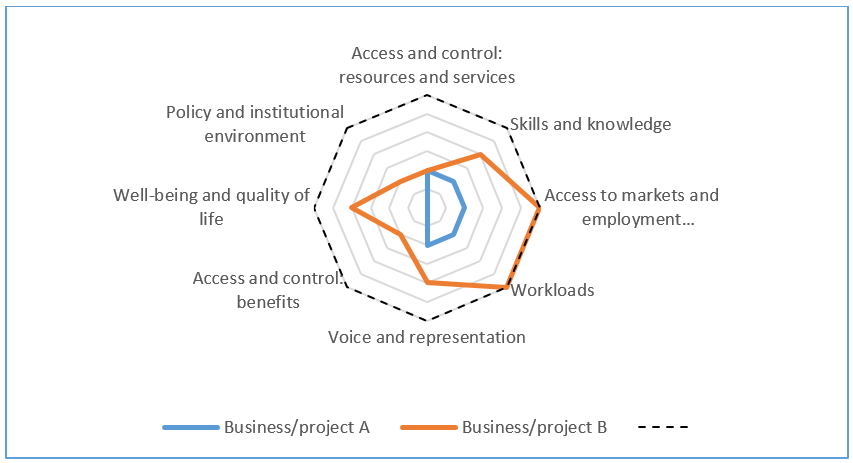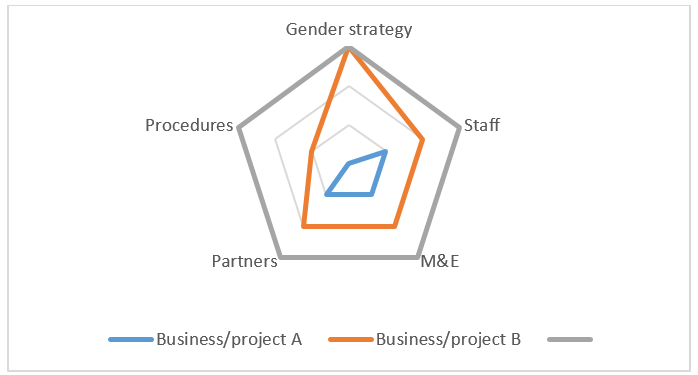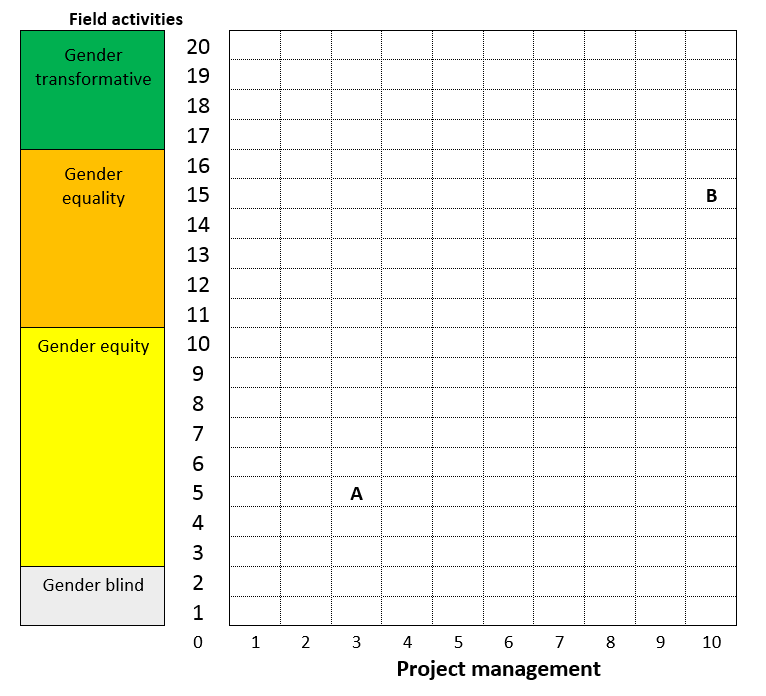A tool for assessing the gender-responsiveness of agribusiness initiatives
Why inclusive agribusiness must include a gender agenda
Women are already very active in the agricultural sector as smallholders, labourers, employees, processors, traders and retailers etc. This contribution is likely to increase with many regions characterised by strong outflows of male migrants, resulting in the further feminisation of agriculture[1].
Recognising and taking account of the differences between women and men in terms of their resources, time availability, motivation etc makes good business sense. Evidence demonstrates that greater attention to addressing gender inequalities in the design and delivery of services or labour recruitment results in improved productivity and more sustainable outcomes[2]. With women being over-represented among those living at the bottom of wealth pyramid – especially households headed by women – there is further justification on the grounds of poverty reduction.
There is now a plethora of excellent documents on how to mainstream gender into the design and delivery of agribusiness/value chain projects. Taking one of the most recent, IFC’s report is particularly relevant because it establishes the business case for adopting a gender perspective at each stage of the value chains and identifies a range of gender-responsive activities[3].
This blog demonstrates a tool that has been developed during a recent study undertaken by the Global Donor Platform for Rural Development on women’s empowerment in agribusiness. It can be used by projects and businesses to: (i) analyse their current performance on gender-related activities at the field level and in project management; and (ii) identify future areas for action. The results of the study piloting this tool will be available in a forthcoming issue.
What are the different levels of gender-responsiveness?
With reference to agribusiness initiatives, there are four main levels of engagement with the gender agenda[4]:
- Do nothing (gender blind or neutral): Activities do not include any specific interventions or mechanisms to promote women’s inclusion or empowerment;
- Do a little (gender equity): Activities that engage with women’s inclusion to level the playing field in the pursuit of productivity and efficiency;
- Do a lot (gender equality): Activities specifically designed to broaden and deepen women’s inclusion and empowerment by taking into account (but not seeking to change) structural barriers; and
- Do something different (gender transformative): Activities specifically designed to generate gender transformative impacts by addressing social norms and structural barriers to women’s inclusion and empowerment.
The boundaries are to some extent fluid. For example, whether an activity is addressing gender equality or is gender transformative depends on context; thus in some cultural settings, training women to be role models or loan officers may be addressing issues of equality whereas in more orthodox settings this would be considered to be transformative. The ratings can also be fine-tuned to reflect the different needs of different types of women, based on their age, family life cycle, household demographics, education, socio-economic status, location and infrastructure, and cultural context.
What are the main areas of gender inequality in agribusiness to address?
There are eight principal domains of gender inequality in agribusiness:
- Access and control over resources and services: these activities focus on enabling women to become more productive in their on-farm or off-farm agri-business activities through accessing: inputs, land tenure arrangements, asset ownership, hire services and financial services;
- Skills and knowledge: these activities develop and strengthen women’s technical, business and entrepreneurship skills through training, events, access to extension services and information;
- Access to markets and employment opportunities: these activities create opportunities for women to deepen or broaden their engagement with the value chain and develop new livelihood opportunities;
- Workloads: these activities include technologies and practices that reduce women’s workload or change the traditional division of labour between women and men in various contexts: home, farm, off-farm and the community, and include public infrastructure such as roads and water supplies;
- Voice and representation outside the home: these activities strengthen women’s voice, participation and representation in decision-making in income-generating groups, producer organisations, community bodies and stakeholder platforms;
- Voice and decision-making, access and control over benefits: these activities strengthen women’s voice in their home and ensure they share in the benefits of their work, particularly at the household level;
- Well-being and quality of life: these activities contribute to improving women’s quality of life by working on norms and practices, engaging with men and boys, developing positive behaviours, providing services and developing life skills; and
- Policy and institutional environment: these activities engage in dialogue with government to create an enabling policy and institutional environment for gender equality and women’s empowerment.
In each domain, different project activities may range from being gender blind or neutral through to transformative.
Also look at project management
There are five dimensions of project management which underpin the design and delivery of gender-responsive field level activities:
- Gender strategy: the presence and implementation of a strategy with a theory of change or results chain that describes how – and the extent to which - women will be empowered; strategy links with annual work plans and budgets, underpinned by detailed studies of the agribusiness sector from a gender perspective;
- Staff: the capacity of project staff to identify and address gender issues in their areas of responsibility, as well as a gender specialist or gender focal point;
- M&E: the extent to which the M&E system captures and analyses outcomes and impact of project activities on gender equality and women’s empowerment through indicators, case studies, sex-disaggregated data and links the findings to management decision-making;
- Partners: the commitment and capacity of partners to identify and address gender issues in the services they provide to agribusiness initiatives; and
- Procedures: the extent to which procedures and conditionalities attached to participation are adapted and delivered from gender perspective.
Analysing performance
Project performance at the field level can be analysed using the gender rating to indicate the extent to which a business/project has introduced activities specifically to address the inequalities. Similarly, project management can also be rated in terms of their support to gender initiatives.
This information can be used: (i) to identify which domains of gender inequality are more typically addressed at the field level and the gaps; and (ii) to identify the stronger and weaker areas of project management.
If there are several projects in a portfolio, this methodology can also be used for a comparative analysis: (i) between gender-related field level activities (Box 1); (ii) between management activities (Box 2); and (iii) correlations between project management and field-level activities (Box 3).
The findings will provide insights into where to channel further efforts to strengthen performance from a gender perspective.
Concluding thoughts
The use of such a tool can sharpen the focus of agribusiness/value chain projects to have greater clarity about what is being delivered from a gender perspective. It can be used during project design, reviews during implementation, and as a basis for project completion assessment.
It can be further developed by establishing: (i) backward linkages to see which specific inequalities are being addressed and the gaps remaining; (ii) forward linkages between activities, outcomes and impacts; and (iii) the allocation of project funds/investments in different domains and levels of empowerment.
Box 1: Domains of gender inequality addressed at the field level
To facilitate the analysis, activities in each domain are scored from 0 = gender blind, 1 = gender equity, 2 = gender equality, through to 3 = gender transformative. The results may be plotted on an octagon; the larger the area, the more gender transformative the field level activities. In this example, business/project A has addressed gender issues largely from an efficiency perspective. Activities have been introduced to ensure women have access to the key inputs and the basic agronomic skills to produce crops in sufficient volume and of a suitable quality as required by the processor. But little attempt has been made to empower women beyond their basic role as producers. In contrast, business/project B has been more gender transformative and introduced several activities to broaden livelihood opportunities for women to engage in new points along the value chain, to act as role models for others and to redistribute responsibilities for unpaid care and domestic work among household members.

The scores may be aggregated across the eight domains for a project and classified at project level: doing nothing/gender blind (aggregate score range 0 – 2); doing a little/gender equity (score 3 – 10); doing more/gender equality (11 – 16); and doing something different/gender transformative (17 and above). Overall, business/project A (with an aggregate score of 5) would be rated as gender equity whereas business/project B (aggregate score of 15) would be rated as gender equality.
Box 2: Dimensions of project management which support gender-related activities in the field
Continuing with the two examples above, business/project A has taken a few measures in place such as the appointment of a gender focal point (but no training), partners with limited experience of addressing gender issues, and collecting (but not analyzing) sex-disaggregated data (SDD). In contrast, business/project B has a more comprehensive approach at the management level, including a gender strategy, a gender specialist on the management team, trained staff and competent partners, and the collection and analysis of SDD.

Box 3: Correlation between field-level activities and project management
The third level of analysis correlates the aggregate scores at the field level with project management initiatives. For each business/project, the scores are aggregated across the eight domains at the field level and across the five management dimensions. The results are plotted and provides key insights to the reasons why some projects are more active and creative in addressing gender inequalities than others. The weak project management capacity to address gender in business/project A is reflected in poor outcomes at the field level (rated as gender equity). In contrast, the more robust gender-responsive management system in business/project B results in a wider range of gender initiatives at the field level (rated as gender equality). It would appear that the management system will largely drive field-level activities.

- This blog is part of a series on what’s new in inclusive agribusiness from April 2017. Hear from more contributors in part one of the series- digging into the details of inclusive business programmes around the world. In part two contributors share how long-standing perspectives on cooperative, corporate strategies, value chain partnerships, market system change, rural livelihoods support, financing, and innovation adoption are beginning to blend, and why.
- Read more on key topics in inclusive agribusiness in the series of six theme papers.
- Access over 450 resources on inclusive agribusiness on SearchInclusiveBusiness.org
Update:
This methodology for analysing agribusiness projects from a gender perspective was developed to review gender-related initiatives at the field level and in project management. The study, commissioned by the Global Donor Platform for Rural Development to understand the extent to which donor-supported agribusiness initiatives engage with the gender transformative agenda is available here (not longer available).
For an overview of the results don't miss these blogs from Clare:
- The gender-responsiveness of agribusiness initiatives: Findings from a survey of 16 projects
- The gender-responsiveness of project management in agribusiness: Findings from a survey of nine projects
[1] Slavchevska V., Kaaria S. and Taivalmaa S.L. (2016) Feminization of agriculture in the context of rural transformations: What is the evidence? World Bank Group Agriculture, Working Paper
[2] UN Women, UNDP, UNEP, and the World Bank Group (2015) The cost of the gender gap in agricultural productivity
[3] IFC (2016) Investing in Women along Agribusiness Value Chains
[4] These tie in with the gender strategies of development projects described by Theis and Meinzen-Dick as reach, benefit or empower (IFPRI blog, 16 December 2016).